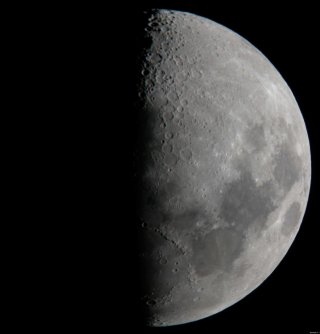One of my favorite things about watching the progression of the moon from almost invisible crescent to first quarter to full is how the most inconspicuous craters one night can metamorphose into the most prominent sights on the moon another night. Tonight, for instance, the little crater Tycho made its first appearance in this lunation (you can see it a little ways in from the southern edge. Look near the bottom of today’s annotated photo, above the not-quite-visible-yet-but-labeled-anyway crater Clavius, site of the moon base in Clarke/Kubrick’s 2001: A Space Odyssey). Tycho is just a sunlit edge and a dark bottom tonight. In fact, the shape of the shadows and sunlit portions of the crater make it look remarkably like a young crescent moon! Come full moon, though, we’ll see a different sight indeed, with rays that seem to go across the entire visible face of the moon!
Speaking of rays, another crater that has been visible throughout this first week has come into much greater prominence tonight: the crater Proclus, out on the western edge of the Mare Crisium (the dark circle on the eastern edge of the moon; I labeled it in every photo until tonight, so if you’re not sure which one it is, just look at the annotated photo for any of days 4 through 7). Proclus is one of the brightest craters on the moon, as the past few nights have shown (I didn’t label it on any of the earlier photos). But what really is remarkable about this crater doesn’t become obvious until tonight: the large and unusually shaped ray system.
It’s that ray system that makes Proclus interesting. Here is what Charles Wood has to say about it in The Modern Moon: A Personal View.
The oval shape shape of dusky Mare Crisium is the most conspicuous feature along the Moon’s eastern rim, but from about first quarter on, a much smaller, bright crater steals the show and provides a long-overlooked clue to the irregular shape of the giant Crisium basin itself. Proclus (28 km in diameter, 2.4 km deep) is one of the very brightest craters on the moon and is remarkable for the asymmetrical pattern of its bright rays. There is a 140° gap in the rays on the southwest side of Proclus. In fact, the countryside to the west of Proclus is noticeably grayer than the ray-covered areas and is one of the few highland regions of the Moon given a name — Palus Somni, the Marsh of Sleep. (93)
As it turns out, the odd pattern of the rays, which puzzled lunar observers for generations, has a simple explanation: the impact that formed the crater occurred at an oblique (shallow) angle—much less than 15° in this case. So, although the crater itself is round (all craters, or nearly all, are round; the few exceptions, like Messier, are craters that have been “scooped out” by exceedingly shallow impacts), the rays don’t go out in all directions equally:
When the impact angle is less than 15°, the ejecta pattern becomes elongated in the downrange direction and a “forbidden zone,” where no ejecta appears, develops in the uprange direction. For grazing impacts of just a few degrees, the rays go sideways only, producing a butterfly-wing pattern. (93)
Gerald North, in his Observing the Moon: The modern astronomer’s guide, mentions something else about Proclus: observers have reported that this crater and its ray system often appear yellowish. North, though, wisely ascribes this color to properties of the optical systems employed rather than to the mysterious TLPs (transient lunar phenomena):
Proclus, and particularly its rays, often takes on a distinctly yellowish colour but this is mainly due to spurious colour (the prismatic effect due to the Earth’s atmosphere that often produces false colours along brightness boundaries in the images of celestial bodies as seen through telescopes). (204)
We almost didn’t get a chance to investigate Proclus and its ray system tonight, though. All day long, I’d been checking the clear sky clock for Boca, and it was looking pretty sketchy:

Cloud cover right up until 2 a.m., but moonset is at 1:29 a.m. Yikes!
But as I rediscovered yesterday, astronomers must grab the main chance. And tonight, right after putting the lad to bed, I poked my head out the back door and sure enough, there was a little tiny sliver of clear sky with the moon in the middle of it. And so, I rushed to snap some photos while I could; in fact, the fussy among you might notice that tonight’s images are a leetle bit fuzzy; I didn’t get enough time to fine-tune the focus (and I’m not very good at fine-tuning the focus anyway).
Tonight’s annotated picture is different from the earlier ones in the series; I decided to flip it in Photoshop, putting north at the top. This matches the layout of the moon in my favorite atlas (Antonín Rükl’s Atlas of the Moon), which reduces the mental gymnastics I’d been going through every night trying to add the feature names (which reduces the chance for embarrassing errors):
no images were found
If you’re having trouble reading the labels from the image, try right-clicking the image and opening it in a new window or tab; then you can enlarge it and play with it as you see fit. And, as usual in this series, the gallery showing this lunation appears below:



























